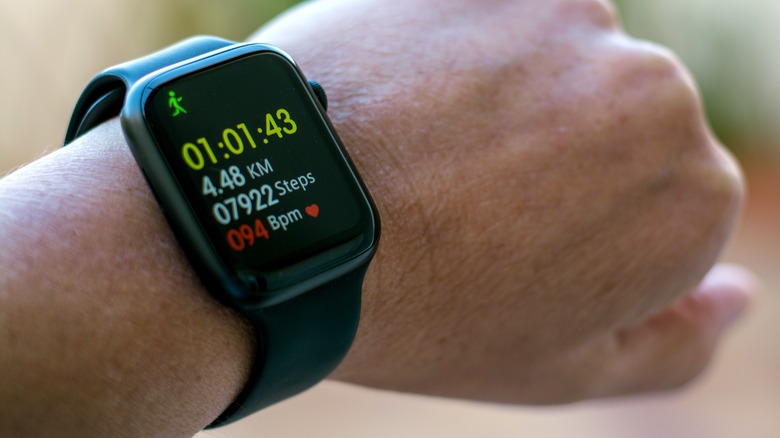What Should You Track If You're Walking For Weight Loss?
When it comes to fitness, figuring out the right method and approach can mean the difference between success and failure. Any activity which requires movement can aid in weight loss by creating additional calorie expenditure, according to the Mayo Clinic. However, some activities, like swimming, may be restricted by availability and season, while other activities may be more intense or difficult for those new to weight loss routines.
Luckily, walking is a popular means of exercise for those looking to shed a few pounds (via Women's Health Magazine). In fact, an additional 30 minutes of walking per day can help increase the success of weight loss attempts, especially when combined with a healthy and balanced diet. As a low-impact form of cardiovascular activity, walking at a brisk pace for approximately 30 minutes can burn up to 150 calories, according to the Mayo Clinic.
Though walking seems like an easy-to-implement activity, there's a bit more to using the activity for weight loss than simply lacing up your tennis shoes and setting out on a stroll through your neighborhood. In addition to knowing the best tips for starting a walking routine, it's important to know what to track to measure your progress.
Benefits of walking
Walking offers a number of health benefits from increased cardiovascular performance, supporting weight loss efforts, reducing your risk for sleep apnea, and even aiding with overall mood, according to Healthline. Some research has even suggested that adhering to a regular walking schedule can help balance both good and bad cholesterol levels in the body. But in addition to being good for your physical health, regularly walking can also provide a beneficial mood boost, aiding with anxiety and helping to improve cognitive functioning, Good Housekeeping explains.
When it comes to walking for weight loss, there are a few important significant factors. First, the amount of calories burned across a period of walking is determined by the body weight of the individual and the pace at which he or she is walking (via Healthline). For example, an individual weighing 200 pounds and walking at four miles per hour will likely burn more calories than someone who weighs 160 pounds, walking at two miles per hour. Therefore, walking for longer periods at a more rapid pace will provide a higher number of calories burned.
Nevertheless, knowing how to measure and track your progress during your walking routine is another important factor for success. Measuring your walking routine can be done by tracking the number of steps taken each day, the distance completed during a walking workout, or the number of minutes spent walking each day (via Today).
What's the best way to track walking workouts?
A common goal for those looking to use walking as a form of weight loss is to try to hit 10,000 steps each day. According to Fitbit, walking 10,000 steps each day can help burn up to 3500 calories each week. For those with fitness trackers, tracking steps can be a great way to help you feel a sense of achievement and daily motivation.
However, another way to measure walking workouts is to determine the distance walked during a specified period. Today explains that for those who do not have access to a step counter, tracking the distance or miles walked can be a great way to measure progress.
Finally, measuring progress through the number of minutes walked can be a great means of ensuring that the daily activity goals you set are maintained. Where tracking steps and distance are good tools, tracking minutes spent walking can provide you with a more focused weight loss attempt. Some days you may not feel like hitting those last 2,000 steps before bed, or jogging out that mile and a half, but tracking your minutes walking can allow you to customize your workout to your daily needs.



